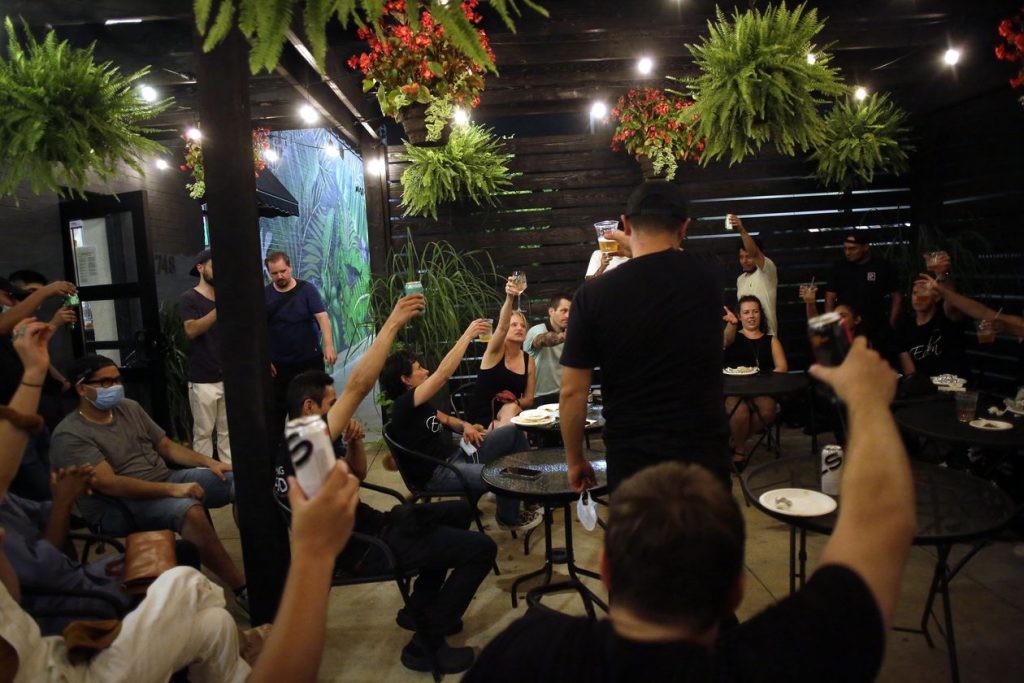
| Photographs by Joshua Lott for The Wall Street Journal
Saturday night at Eden, a restaurant in Chicago’s West Loop neighborhood, felt almost normal. Its roughly 80 tables were full—albeit spaced apart—as customers dined on tagliatelle with pork, lamb shank, cocktails and bottles of wine.
“We sold out of everything,” co-owner Jodi Fyfe said. “The whole evening was just beyond beautiful.”
It was Eden’s last night in business. The New American restaurant hung on through the first wave of the coronavirus pandemic by converting to a market and reopening for diners this summer. But Eden’s owners say the latest surge in virus cases, and the drop-off in customers willing to eat indoors, was too much.
Uncertainty surrounding indoor dining is prompting tough decisions at restaurants across the country. Government aid has run out, and breaks from landlords and suppliers are coming due as fewer diners are willing to eat inside, a combination of factors pushing restaurants like Eden to the breaking point. Thousands of restaurants have closed so far, and as many as 10% of independent operators could shut by year’s end as a result of the new coronavirus, according to financial-services firm Stephens.
Eden started out the year serving more diners than ever, but in a few months found itself fighting to stay in business, said Ms. Fyfe, who along with her husband, Devon Quinn, opened the restaurant four years ago.
The couple created a takeout menu and on-site market in spring and added outdoor seating this summer under a tent used by its catering business.
Eden opened indoor dining last month. But as public-health authorities raise concerns about the risks of eating indoors, demand wasn’t enough to cover costs, Ms. Fyfe said, adding that outdoor dining won’t work in Chicago come fall.
“I don’t feel there is any glimmer of hope,” said Ms. Fyfe, 50 years old. “People are too afraid to eat inside.”
Lights Out
According to stats from Yelp’s website, over 15,000 U.S. restaurants have permanently closed during the coronavirus pandemic.
Indoor dining has been halted at nearly 90,000 restaurants across the country, according to the National Restaurant Association, a trade group. Plans to resume indoor dining in places including New York City and New Jersey are also in limbo, and on Monday Chicago announced the suspension of indoor service at eateries and bars.
Many restaurant owners tapped the federal Paycheck Protection Program and negotiated breaks with their landlords. Now, some who got PPP loans say that money has been spent. And many landlords who offered rent deferments of a few months now want to be paid in August, said Alden Parker, co-chair of Fisher & Phillips’s National Hospitality Practice Group.
August 1 looks like a day of reckoning,” Mr. Parker said.
Particularly vulnerable are restaurants concentrated in downtown commercial corridors where few office workers have returned, said Mr. Parker, pointing to the closure of a chain based in the San Francisco area, Specialty’s Café & Bakery, after 33 years of operations.
“Some segments are doing OK and some segments are just doing terrible right now,” he said, adding that fast-food restaurants with drive-through customers have generally fared better than sit-down eateries.
More than 2,200 California restaurants have closed since the pandemic hit, according to Yelp Inc. Federal figures show the state had roughly 81,500 restaurants last year, the largest number overall. In Arizona, 9% of roughly 10,000 restaurants operating before the pandemic have closed, according to the Arizona Restaurant Association. About 1,000 of Michigan’s 17,000 restaurants had permanently closed as of last month, the state’s restaurant and hotel group said.
The National Restaurant Association estimates that tens of thousands of restaurants will close as a result of the pandemic by year’s end.
When Eden closed its dining room in March, it furloughed all but 40 of its 500 employees. The restaurant created a market of housemade baked goods, staff-selected wines, and produce grown in its greenhouses, including edible flowers and lettuces. The market cost money to run, however; Eden’s chef, for example, spent several hours a day tending to the on-site greenhouse.
After the city opened outdoor dining last month, Eden converted its parking lot into a 60-seat al fresco eatery under a tent typically used by its catering division. It brought back about 20 of its 90 indoor tables when the city allowed it to restart late last month, and invested in masks and gloves for workers. It cleaned surfaces and bathrooms roughly every 30 minutes.
Indoor demand withered to roughly 10 to 20 guests a night as coronavirus case counts began rising recently, Ms. Fyfe said. And outdoor dining could be tough to predict: A rainy night resulted in a rash of cancellations, setting off a chain of losses.
Eden harvests produce from its greenhouse and bakes desserts and bread to match the number of customers it expects to serve on a given night. In normal times, those products also go to catering for downtown offices and weddings, businesses that have also dried up, she said.
Eden got a PPP loan for less than the $150,000 threshold required for federal disclosure, and used it to pay part of the lease and utilities. Eden’s landlord declined to give the restaurant a break, Ms. Fyfe said. She and her husband last drew a paycheck in February, she said; they moved to a smaller apartment to save money. Exhausted, they drafted a note to guests last week announcing Eden would close.
“Our whole lives went into this,” Ms. Fyfe said. The business will continue in smaller form as a catering business, and the company will keep the greenhouse to grow produce. More workers will be laid off.
“In 34 years in the business, I’ve never seen anything like this,” she said. “There’s only so much you can do.”